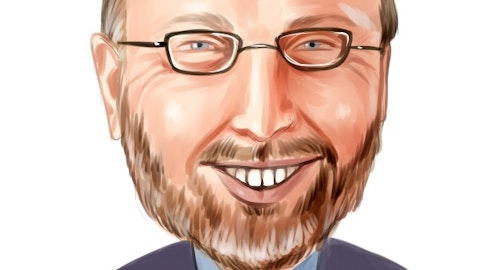Mark Donohue: Next question, please. Lydia? Please standby, I think we’re experiencing technical difficulty.
Operator: Thank you. Our next question comes from Heather Balsky of Bank of America.
Heather Balsky: Hi. This is Heather Balsky. Thanks for taking my question. I was hoping you could talk a little bit more about the increase in CapEx spend and the investment spend you’re doing, and just help us understand how much of it is GenAI initiatives, how much of it is other investments in the business? And how — you talked about investing to drive growth, just how we should think about spend over the next few years? And how you’re thinking about if there’s incremental opportunities to invest just balancing that with the margin growth and cash flow growth? Thanks.
Jonathan Collins: Yeah. Thank you for the question, Heather. So, with respect to our CapEx increase, most of that is adding development capacity, which we capitalize at a relatively high rate when we’re enhancing and improving products. So, maybe, I’ll just touch on a couple of the areas that Jonathan mentioned a bit ago. In the A&G segment, we continue to ramp up the investment in the Web of Science to stay ahead of adding features to the platform and ingesting new mediums of content to make it a great experience. And there certainly is an AI overlay there. All of our businesses are starting to move towards conversational discovery, which is an example of embedding AI in the products, and it certainly comes with development effort in all of those areas.
Web of Science certainly doing that as well. As we move into Life Sciences, it’s a combination of development capacity and some content or data for the real-world data offering. As Jonathan highlighted, we spent a lot of effort in the past couple of quarters building out pharma-grade data and the technology investment there. And then the next step for us is start to build these therapy area platforms or offerings that will take meaningful development efforts. So, that’s really how we’re spending within the Life Sciences segment. And then, on the IP side, the four new platforms or modules that will be put on top of the Derwent data set for search, for watch, for strategy, and for R&D, those applications have pretty meaningful technology developments that will happen over the course of this year and into next year.
Just in terms of the time horizon, we indicated last year and the cash flow guidance that we highlighted today, getting to that greater than or about 50% conversion in a couple of years does contemplate CapEx being at a reasonably steady dollar level over the next few years. As revenue grows, that margin on CapEx should drop a bit, but we do expect that we’ll need to continue to make that investment over the next few years. Thanks for the question.
Mark Donohue: Next question, please.
Operator: Our next question comes from Toni Kaplan of Morgan Stanley. Your line is open.
Greg Parrish: Hey, good morning. This is Greg Parrish on for Toni. Thanks for taking our question. I just want to dig into the change since Investor Day in March. I mean, what really drove the difference in the turnaround trajectory that you were targeting? You’re ramping up investment here. So, is more investment required than you thought back then, or they really just macro, or is the end market more challenged maybe than you thought? If you can kind of help bridge the gap there? Thanks.
Jonathan Gear: Sure, Greg. And the way I think about it, and I encourage you to think about it, is really two different things. First is macro certainly impacted us far more than we were anticipating in 2023, primarily in IP, and we talked about that in our Q2 call also in Life Sciences & Healthcare with commercial markets there. Those were the most impacted. And to a lesser degree, with some — on the margin within A&G with some discretionary transactional items. But, primarily, again in Life Sciences & Healthcare and IP. So, macro was part of it. So, it ended up impacting kind of our starting point, if you will, on the three-year plan. And the other element of it really was around — as we brought in more — brought back in more industry expertise back into the business as we reestablished some of the teams that we’d had before, we began to slightly modify and change some of our go-to-market product strategies, particularly around Life Sciences & Healthcare.
And with Henry coming on board middle of last year, spending time with him, again, we really made a decision to change our Life Sciences & Healthcare RWD platform strategy. Absolutely the right thing to do and it makes me even more confident in the future. But that did pull us back a year in terms of the timing around that platform. So, those are really the two kind of key areas I would call out. Thank you.
Mark Donohue: Great. Thank you. Next question, please.
Operator: Next question is from George Tong of Goldman Sachs. Please go ahead.
George Tong: Hi. Thanks. Good morning. It looks like in your guide you’re expecting improved organic growth this year in subscription and reoccurring. It’s really the transactional piece that’s going to be the offset. So, can you talk a little bit more about how much of the transactional revenue headwinds are cyclical versus structural, and steps that you’re taking internally to drive improved performance here?
Jonathan Collins: Sure, George. Yeah. Just to reiterate what this year’s guidance range contemplates on organic growth. So, we do believe that the subscription business will be relatively consistent with last year. We grew about 2.5% last year. I think we’ll be in that 2% to 3% range. As Jonathan highlighted, those investments that we are making this year in Life Sciences and in Patent Intelligence within IP should start to improve usage in the second half of this year and help the lift subscription growth next year. And we should continue to see some traction in A&G as the Web of Science product continues to improve. Most of the impact in reoccurring, which we think will grow modestly this year, is going to come from a modest improvement in the second half of the year on volumes within that market.





